Zlín
Zlín (Czech pronunciation: [zliːn]; German: Zlin) is a city in southeastern Moravia in the Czech Republic, the seat of the Zlín Region, on the Dřevnice river. The development of the modern city is closely connected to the Bata Shoes company and its social scheme, developed after the First World War. From 1949 to 1990, the city was renamed Gottwaldov.
Zlín | |
|---|---|
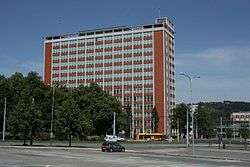 Iconic constructivist Baťa's Skyscraper | |
 Flag  Coat of arms | |
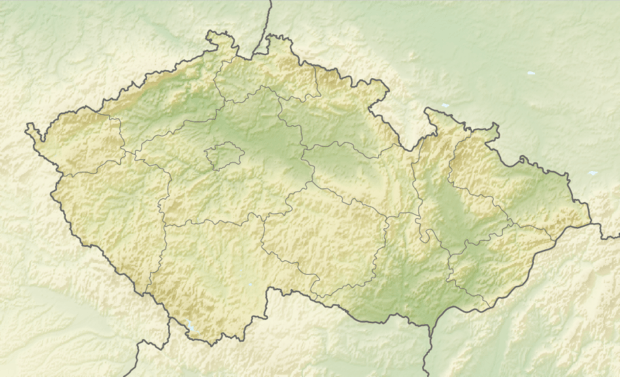 Zlín Location in the Czech Republic | |
| Coordinates: 49°13′59″N 17°40′1″E | |
| Country | |
| Region | Zlín |
| District | Zlín |
| First documented | 1322 |
| Government | |
| • Mayor | Jiří Korec (ANO) |
| Area | |
| • Total | 102.83 km2 (39.70 sq mi) |
| Elevation | 230 m (750 ft) |
| Population (2020-01-01[1]) | |
| • Total | 74,935 |
| • Density | 730/km2 (1,900/sq mi) |
| Time zone | UTC+1 (CET) |
| • Summer (DST) | UTC+2 (CEST) |
| Postal code | 760 01 |
| Website | www.zlin.eu |
History
The first record of Zlín dates back to 1322, when it served as a craft guild center for the surrounding area of Moravian Wallachia. Zlín became a town in 1397. During the thirty years war, the residents of Zlín, along with people from the whole Wallachian region, led an uprising against the Habsburg monarchy.
Until the late 19th century, the town did not differ much from other settlements in the surrounding area, with the population not surpassing 3,000. Though historically associated with Moravian Wallachia, Zlín stands at the corner of three historical Moravian cultural regions; Moravian Wallachia, Moravian Slovakia and Hanakia.
Zlín and Tomáš Baťa (1894–1932)
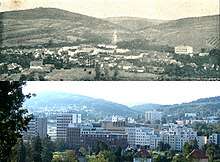
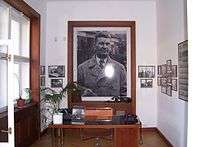
.jpg)

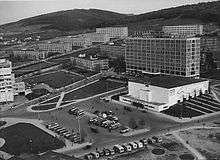
The town grew rapidly after Tomáš Baťa founded a shoe factory there in 1894 when the population was approximately 3,000 inhabitants. Baťa's factory supplied the Austro-Hungarian army in World War I as the entire Moravia region was part of the empire. Due to the remarkable economic growth of the company and the increasing prosperity of its workers, Baťa himself was elected mayor of Zlín in 1923.
Baťa became the leading manufacturer and marketer of footwear in Czechoslovakia in 1922. The factory in Zlín was modernized and expanded before 1927. Tomáš Baťa created a distinct management system around 1924 and sought convergence of interests of entrepreneurs and employees. Besides producing footwear, the company diversified into engineering, chemistry, rubber technology and many more areas. The factory hired thousands of workers who moved to Zlín and lived there in large, sprawling garden districts. Between 1923 and 1932, the number of Baťa employees in Zlín grew from 1,800 to 17,000; the city population increased from 5,300 to 26,400. In those years, the number of trades and crafts increased from 150 to 400. Apart from the Baťa company, there were about five other shoe factories in the city. A network of quality schools, a large hospital, and a number of cultural and physical education associations were available to the residents of the town.
In 1929–1932, Tomáš Baťa set up branch offices in more than twenty countries in Europe including United Kingdom, Africa, Asia, United States, and Canada. Stores and footwear factories in these countries were managed from the headquarters in Zlín. Baťa Company employed a total of 31,000 people in 1932. Factories and adjacent residential districts were built according to the model of Zlín in the following locations:
The city in 1932–1945
Tomáš Baťa died in a plane crash in July 1932. The company was then managed by Jan A. Baťa, Hugo Vavrečka and Dominik Čipera, who also became the mayor. The Baťa company and also the city of Zlín continued growing. In 1929–1935, a strong economic agglomeration Zlín – Otrokovice – Napajedla has developed. In 1935, the city became the seat of the administrative district and strengthened its position in eastern Moravia. New secondary schools were added to the network of educational establishments. The population increased from 26,400 to 37,400 between 1932 and 1939, the number of employees of the Baťa company grew from 17,000 to 22,000; the number of trades and crafts increased from 400 to 1,100 (1937).
The development of Baťa enterprises abroad continued. By 1938, there were stores and factories in 38 countries and the number of employees reached 65,000.
During World War II (1939–1945) life in the city was under the influence of German occupiers. The management of the large global company had to be split. The Zlín management of the Baťa company (D. Čipera, H. Vavrečka, J. Hlavnička) affected businesses in the Protectorate of Bohemia and Moravia, and in certain European countries. Jan A. Baťa lived in the United States (1939–1941) and then settled in Brazil. Thomas J. Bata exiled to Canada in 1939. Zlín was hit by war in the autumn of 1944, when the city was bombed and suffered significant damage. A group of partisans and resistance fighters fought against the Nazis in the vicinity of Zlín in 1944–1945. Zlín was liberated by the Soviet and Romanian armies on May 2, 1945.
Postwar era
The communists took over management of Zlín and Baťa factories in May 1945, and in October the Bata company in Czechoslovakia was nationalized. Zlín was renamed Gottwaldov in 1949 – after the first communist president of Czechoslovakia – Klement Gottwald. The city developed its position as administrative, economic, educational and cultural center of Eastern Moravia. The local technology faculty became active in 1969. The appearance of the city was significantly influenced by the construction of housing from renowned architects commissioned by Bata in the 1930s. All though they appear "Soviet Era" most are from the 1930s. A new city theater building, ice hockey stadium and other facilities were built as well.
After the Velvet Revolution in 1989, the city's name was changed back to Zlín as of January 1, 1990. Thomas J. Bata came to visit the town immediately and established a branch of his company there in 1991. It became the seat of the newly formed Zlín Region in 2000. Tomas Baťa University, which follows the older traditions of local higher education, was founded in Zlin in 2001.
Architecture in Zlín
Urban utopia

.jpg)

The city's architectural development was a characteristic synthesis of two modernist urban utopian visions: the first inspired by Ebenezer Howard's Garden city movement and the second tracing its lineage to Le Corbusier's vision of urban modernity. From the very beginning Baťa pursued the goal of constructing the Garden City proposed by Ebenezer Howard. However, the shape of the city had to be 'modernized' so as to suit the needs of the company and of the expanding community.
Zlín's distinctive architecture was guided by principles that were strictly observed during its whole inter-war development. Its central theme was the derivation of all architectural elements from the factory buildings. The central position of the industrial production in the life of Zlín inhabitants was to be highlighted. Hence the same building materials (red bricks, glass, reinforced concrete) were used for the construction of all public (and most private) edifices.
The common structural element of Zlín architecture is a square bay of 20x20 feet (6.15x6.15 m). Although modified by several variations, this high modernist style leads to a high degree of uniformity of buildings. It highlights the central and unique idea of an industrial garden city at the same time. Architectural and urban functionalism was to serve the demands of a modern city. The simplicity of its buildings translated into its functional adaptability was to prescribe (and react to) the needs of everyday life.
The urban plan of Zlín was the creation of František Lydie Gahura, a student at Le Corbusier's atelier in Paris. Le Corbusier's inspiration was evident in the basic principles of the city's architecture. On his visit to Zlín in 1935, he was appointed to preside over the selective procedure for new apartment houses. Le Corbusier also received a commission for creating the plan for further expansion of the city and the company. His plan represented a paradigm shift from his earlier conceptions of urban design. Here he abandoned an anthropomorphic, centralized city model in favor of the linear city format. The change in Le Corbusier's thinking was reflected by the abandonment of the à redents residential pattern in favor of free-standing slab blocks. His Zlín plan, however, was never fully adopted.
Architectural highlights
- The Villa of Tomáš Baťa was an early architectural achievement in Zlín (the construction was finished in 1911). The building's design was carried out by the famous Czech architect Jan Kotěra, professor at Prague's Academy of Fine Arts. After its confiscation, in 1945, the building served as a Pioneers' house. Being returned to Tomáš J. Baťa, the son of the company's founder, the building now houses the headquarters of the Thomas Bata Foundation.
- Baťa's Hospital in Zlín was founded in 1927 and quickly developed into one of the most modern Czechoslovak hospitals. The original architectural set up was designed by František Lydie Gahura.
- The Grand Cinema (Velké kino) was built in 1932 and became the largest cinema in Europe (2580 seated viewers) in its time. The cinema also boasted the largest movie screen in Europe (9 x 7 meters). This technological marvel was designed by the Czech architects Miroslav Lorenc (1896–1943) and František Lydie Gahura.
- Tomas Bata Memorial was built in 1933 by František Lydie Gahura. The original purpose of the building was to commemorate the achievements of Baťa before his unexpected death in a plane crash in 1932. The building itself is a constructivist masterpiece. It has served as the seat of the Bohuslav Martinů Philharmonic Orchestra since 1955.
- Baťa's Skyscraper (Baťův mrakodrap, Jednadvacítka) was built as the headquarters for the worldwide Baťa organization. Designed by Vladimír Karfík, the huge building was erected in 1936–1939. It included a room-sized elevator housing the office for the boss, comfortably furnished – with a sink, a telephone, and air conditioning. When it was built it was the tallest Czechoslovak building (77.5 m). After a costly reconstruction in 2004, it became the seat of the Zlín Region and the headquarters of the tax office.
Education
The city is home to the Tomas Bata University in Zlín, which opened in 2001. With approximately 12,000 students, it ranks as a medium-sized Czech university, and offers courses in technology, economics, humanities, arts and health care.
Culture
Given Zlín's history as one of the biggest centres of filmmaking in the Czech Republic, probably the biggest cultural event is the International Film Festival for Children and Youth.
International music festival Masters of Rock takes place in near town of Vizovice, while winter version (Winter Masters of Rock) on it takes place in Zlín. MoR focuses mainly on heavy metal and symphonic metal, while on WMoR often perform death metal bands.
Sport
Zlín's ice hockey team, PSG Zlín, plays in the Czech Extraliga and has won two national titles, first in 2004 and the second one in 2014. The football team, FC Fastav Zlín, plays in the first level of Czech professional football, the Czech First League, having played there sporadically since 1993. The city also has teams in other sports including volleyball, basketball, Czech handball, softball and rugby.
Public transport
Public transport in Zlín has a long history. In 1899 Zlín was connected with to the railway network, helping its expansion. In the 1920s local passenger transportation started to operate. Later, in 1939 the town council decided to build three trolleybus routes, numbered lines A, B and C. New trolleybus lines were finished in 1944, after the construction proceeding during the Nazi occupation. Through the times, Zlín's public transport, now owned by DSZO (Zlin & Otrokovice Transportation Company), was one of the fastest-growing public transportation networks in the Czech Republic.
The city is currently served by 14 bus routes and 14 trolleybus routes, and also railway services on line 331, which runs from Otrokovice (located on the international corridor) to Vizovice. There are nine stations on this line within the city of Zlín, the largest of which is Zlín střed (Zlín central).
Notable people
- Miloslav Petrusek (1936–2012), sociologist
- John Tusa (born 1936), British arts administrator, and radio and television journalist
- Tom Stoppard (born 1937), British playwright and screenwriter
- Eva Jiřičná (born 1939), architect
- Ivana Trump (born 1949), Donald Trump's first wife
- Vladimír Hučín (born 1952), dissident and political celebrity
- Roman Čechmánek (born 1971), ice hockey player
- Tomáš Dvořák (born 1972), multiple world champion in decathlon
- Daniel Málek (born 1973), breaststroke swimmer
- Roman Hamrlík (born 1974), ice hockey player
- Petr Čajánek (born 1975), ice hockey player
- Petr Janda (born 1975), architect
- Jiří Novák (born 1975), tennis player
- Silvia Saint (born 1976), pornographic film actress
- Jan Zakopal (born 1977), footballer
- Karel Rachůnek (1979–2011), ice hockey player
Twin towns – sister cities



.svg.png)





Gallery
 Baťa's Skyscraper
Baťa's Skyscraper Baťův institut
Baťův institut Baťův institut
Baťův institut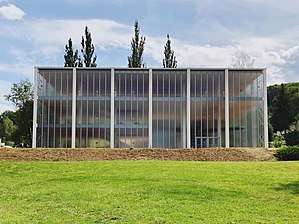
.jpg) Park Komenského
Park Komenského.jpg) Park Komenského
Park Komenského Congress Center Zlín
Congress Center Zlín Congress Center Zlín
Congress Center Zlín.jpg) PRIOR Zlín
PRIOR Zlín- Lešná Castle
References
- "Population of Municipalities – 1 January 2020". Czech Statistical Office. 2020-04-30.
- "Partnerská města" (in Czech). Statutární město Zlín. Retrieved 2020-06-07.
Bibliography
- Frampton, Kenneth (2001). Le Corbusier. London and New York: Thames and & Hudson World of Art.CS1 maint: ref=harv (link)
- Meller, Helen (2001). European Cities 1890-1930s. History Culture and the Built Environment. Chichester (UK): John Wiley & Sons, Ltd.CS1 maint: ref=harv (link)
External links
| Wikimedia Commons has media related to Zlín. |
- Official website
- Public Transport Official Site
- Aviation company Zlin Aircraft a.s. established by T. Bata 1934
- Zlinternational is an internet portal for internationals in Zlin founded by Erasmus students studying at the Tomas Bata University
- history of Zlin, old photos and postcards